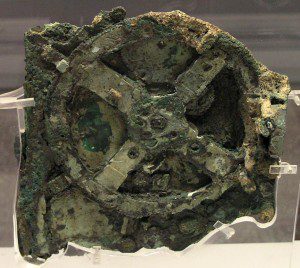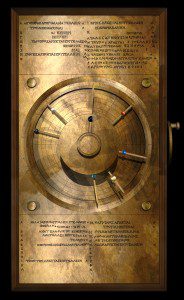
In the summer of 1900 some sponge divers came across an ancient wreck offPoint Glyphadia on the Greek island Antikythera. The salvaged a number of artifacts most of which were packed up and sent to the National Museum of Archeology in Athens.
Two years later, on this day, the 17th of May, 1902, Valerios Stais, the museum’s director noticed a particularly unusual artifact among the collection. It has come to be called the Antikythera mechanism among the more technical crowd and the first analog computer by the popular press.
I’m going with analog computer.
At first he believed it to be an astronomical clock. The machine was fused into rock and at the time they just couldn’t do further research with it. In the nineteen fifties some scientists turned their attention back to the machine, but it wasn’t until 1971 that x-ray and gamma-ray images could be taken of the 82 fragments they had in their possession. And then in 2006 it was further examined through CT scans.
It is generally dated to the late second century before the common era.
Jo Marchant writing in Smithsonian Magazine described it. “The Antikythera mechanism was similar in size to a mantel clock, and bits of wood found on the fragments suggest it was housed in a wooden case. Like a clock, the case would’ve had a large circular face with rotating hands. There was a knob or handle on the side, for winding the mechanism forward or backward. And as the knob turned, trains of interlocking gearwheels drove at least seven hands at various speeds.
“Instead of hours and minutes, the hands displayed celestial time: one hand for the Sun, one for the Moon and one for each of the five planets visible to the naked eye—Mercury, Venus, Mars, Jupiter and Saturn. A rotating black and silver ball showed the phase of the Moon. Inscriptions explained which stars rose and set on any particular date. There were also two dial systems on the back of the case, each with a pin that followed its own spiral groove, like the needle on a record player. One of these dials was a calendar. The other showed the timing of lunar and solar eclipses.”
 Kristina Killgrove writing for Mental Floss, tells us. “Consisting of at least 30 bronze gears in a wooden container that was only the size of a shoebox, the clockwork mechanism was highly advanced for its time. By turning a hand-crank, the user could move forward or backward in time. The crank made the gears move and rotate a series of dials and rings on which there are inscriptions and annotations of Greek zodiac signs and Egyptian calendar days.
Kristina Killgrove writing for Mental Floss, tells us. “Consisting of at least 30 bronze gears in a wooden container that was only the size of a shoebox, the clockwork mechanism was highly advanced for its time. By turning a hand-crank, the user could move forward or backward in time. The crank made the gears move and rotate a series of dials and rings on which there are inscriptions and annotations of Greek zodiac signs and Egyptian calendar days.
“It seems that the information to build such a mechanism was lost through time, perhaps because it was a specialty device or expensive to create. Similar astronomical clocks didn’t reappear in Europe until the 14th century. Since inventions like this do not usually come from nothing, though, many researchers think that we may yet find older precursors in an archaeological context some day.”
So, by some reasonable definitions, a computer. It could calculate dates and predict astronomical events. With, it should be added, astonishing accuracy.
Clever creatures, these humans.
Too bad they’re so dangerous.












